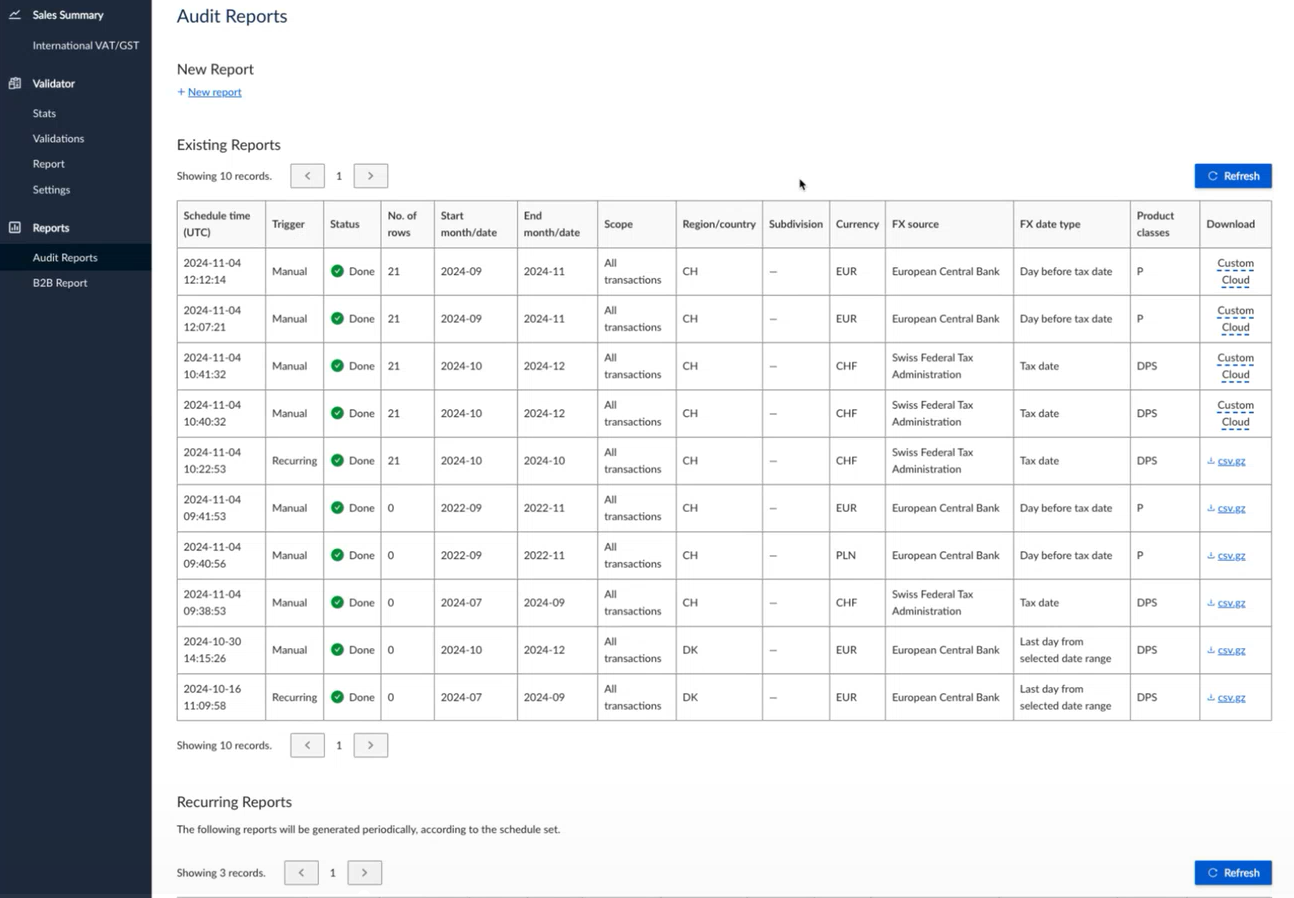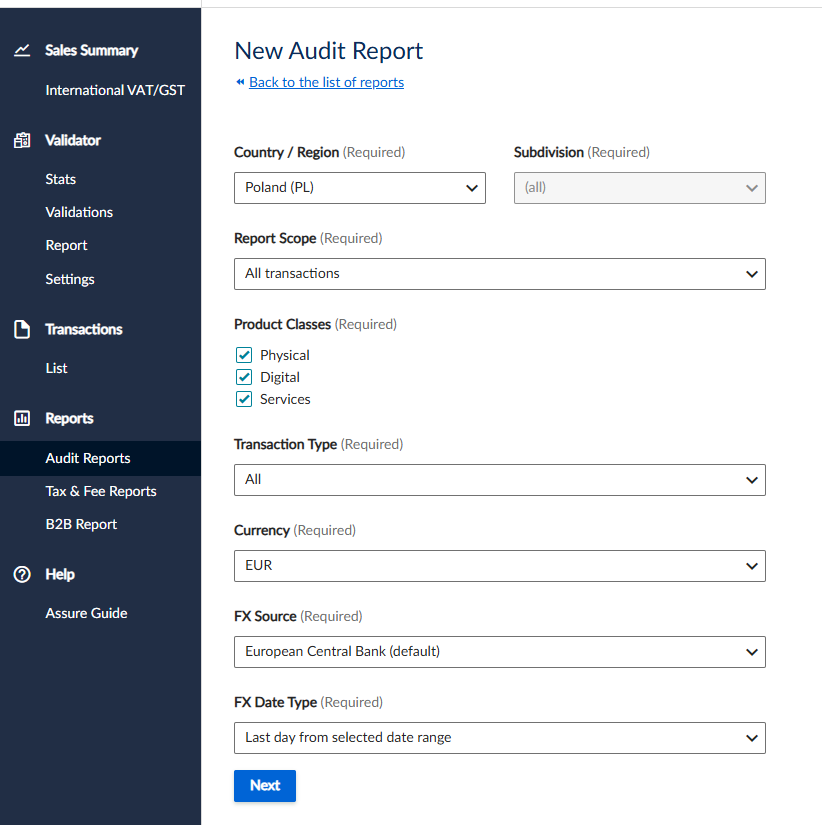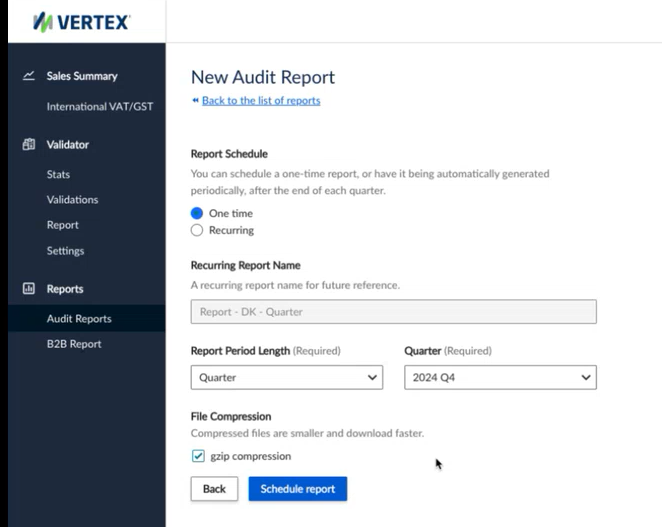Audit Report
The Audit report details the liability per line item and shows the relevant tax rates, shipping information, currency conversion information, and other transactional data provided by the Marketplace.
Reports can be scheduled as once off or as recurring. You can create them using the UI or the API.
To access it, open the UI and click Audit Report -> New report. Choose your filters and schedule it to run as a once off or at recurring intervals.
Many of the fields listed above are also returned in the transaction response when the transaction is confirmed (these fields are detailed in the Transaction Fields and Transaction Lines Object Fields topics). You can use these API response fields to provide liability data to your own reporting applications or ERP systems.
API-based Reporting
This topic describes how to use the UI to create reports. You can also use the API to integrate reports in your applications. See Reporting API.
Report Storage
You can use the service's storage or you can connect your own custom Cloud storage location to store reports. Details are provided in the Report Storage topic.
Report UI
The Audit Reports UI shows existing reports. It is divided into 2 sections:
- Existing Reports: Shows all complete reports.
- Recurring Reports: Shows all recurring reports.

Audit Reports UI
The following fields are displayed as columns on the UI:
| Field | Description |
|---|---|
| Schedule time | The time the report or instance of the report is scheduled to run. |
| Trigger | Whether the report was a once off (Manual) or a recurring report (Recurring). |
| Status | The status of the report such as Done. |
| No. of rows | The number of rows in the report. |
| Start month/date | The month the reporting period starts in. |
| End month/date | The month the reporting period ends in. |
| Scope | The scope of the report. See Report Scope Values. |
| Region/country | The region or countries covered by the report. |
| Subdivision | Country subdivisions covered by the report. |
| Currency | The report's currency. All amounts will be converted to this amount. |
| FX source | The source of rates for currency conversions. |
| FX date type | The date used for currency conversions. |
| Product classes | The product class. See Product Classes. |
| Download | Click the link in this column to download the report file. |
Creating Reports
To create a report, click New Report. The following UI is displayed:

New Audit Report UI
The following filters are available. All are required:
| Filter | Description |
|---|---|
| Country/Region | Select a country or region. |
| Subdivsion | Select a country subdivision, if one exists. |
| Report Scope | Specify the parties you want to be in the report such as the Platform, Seller or Buyer or for all three combined. You can also filter data for self-billed transactions. See Report Scope Values. |
| Product Classes | Choose the product classes that are in the report. See Product Classes. |
| Transaction Type | Select Sales or Refunds. |
| Currency | Choose the currency that you want to apply to the report. Any transactions in other currencies will be converted and displayed in columns prefixed with FX converted in the column name. |
| FX Source | Specify the source of the rate used in currency conversions. Currency conversions can use a number of different FX sources. For example, the ECB means the rate was supplied by the European Central Bank. |
| FX Date Type | Choose one of the following date types for currency conversions: - Order date: The date of the transaction or the order date provided with the transaction. - Day before order date: The rate that was available on the system on the day of the transaction. - Last day from selected date rate: The rate is taken on the last day of the reporting period. |
Complete the selection and click Next to schedule the report.
Scheduling Reports
After you complete the filter selection, you need to schedule the report. Use the Report Schedule section of the New Audit Report UI to do so. The UI is shown in the following screenshot:

Report Scheduling UI
To schedule a report, complete the following steps:
- Under Report Schedule to schedule a report. You can make it a one off or you can have it recur.
- If you do create a recurring report, you can name it in the Recurring Report Name section.
- Select the range of the reporting period. These values are inclusive.
- Choose if you want to compress the output file. Click the gzip compression checkbox to do so.
Post Processing
Downloading Reports
To download a report, open the Audit Report UI and click the link in the Download column.
Output Fields
The following columns are output in the CSV file:
| Column Name | API Field | Type | Description |
|---|---|---|---|
| Transaction type | invoice_status | String | Type of transaction, usually either a sale or a refund. |
| Product class | product_class | String | The product class indicates the type of product. See Product Classes. |
| Transaction kind | kind | String | Shows the type of transaction. For example, it can be b2c. |
| Import Country Code | n/a | String | The code that represents the import country. |
| Tax liability owner | tax_liability_owner_code | String | The party responsible for settling the tax owed to the Tax Authority (Platform, Seller, Buyer). |
| Invoice number | invoice_number | String | The number of the invoice for the transaction. |
| Seller platform name | n/a | String | The name of the platform that the Seller is selling from. |
| Seller platform code | n/a | String | The unique identifier of the platform in the the service. |
| Seller customs ID | custom_id | String | A custom identifier associated with the seller. |
| Invoice date | invoice_timestamp | String | The date the invoice was issued. |
| Refund date | refund_timestamp | String | The date the refund was created and the credit note issued. See Refunds. |
| Currency code | currency_code | String | The currency of the transaction. |
| Target currency code | n/a | String | The currency of the tax report. |
| Tax country code | tax_country_code | String | The country code of the tax authority. |
| Tax country subdivision code | tax_country_subdivision_code | String | The country subdivision code of the tax authority. |
| Tax country name | n/a | String | The long name of the country of the tax authority. |
| Fx source | fx_source | String | The source of the exchange rate used to calculate the tax due in the currency of the tax authority. |
| Exchange rate | fx_rate | String | The exchange rate used to calculate the tax due in the currency of the liable Tax Authority. This occurs when the Tax Authority's currency is different from the one specified in the currency_code field in the transaction. |
| Exchange rate date | fx_date | String | The date that the exchange rate was calculated if a foreign currency exchange is required. For example, when the Tax Authority's currency is different from the one specified in the currency_code field in the transaction. |
| Product CN code | product_cn_code | String | An optional field that you can use to specify a product code. |
| Product tax identifier | n/a | String | An identifier of the tax associated with this product. |
| Product reference number | n/a | String | A reference number that can be used to identify the product. |
| Amount | amount | String | The tax exclusive amount from the transaction. |
| Discounted amount | discount_amount | String | The discount amount excluding tax. See Discounts. |
| Tax amount | tax_amount | String | The tax amount of the transaction (in the original currency of the sale). |
| Discounted tax amount | discount_tax_amount | String | The discounted tax amount. See Discounts . |
| FX converted amount | n/a | String | The tax exclusive amount converted to the report's currency. |
| FX converted tax amount | n/a | String | The tax inclusive amount converted to the report's currency. |
| Total amount | total_amount | String | The total amount, including tax, of the transaction. |
| Discounted total amount | discounted_total_amount | String | The discount amount including tax. See Discounts. |
| Buyer tax number | buyer_tax_number | String | The buyer's tax number. See Vertex Validator. |
| Buyer tax number valid | buyer_tax_number_valid | Boolean | Indicates whether the buyers tax number is valid. See Vertex Validator. |
| Reverse charge | reverse_charge | Boolean | Indicates whether a reverse charge applies. |
| Tax exempt | tax_exempt | Boolean | Indicates if the transaction is exempt from tax. |
| FX converted total amount | n/a | String | The total amount, including tax, of the transaction, converted to the report's currency. |
| Liability rule applied | tax_liability_rule | String | The rationale behind the assignment of the tax liability owner. |
| IOSS/OSS | special_tax_scheme | String | Indicates whether the transaction qualifies for IOSS or OSS. See Import One Stop Shop (IOSS) and One Stop Shop (OSS). |
| Special tax scheme | special_tax_scheme | String | Indicates if the transaction qualifies for a special tax scheme such as IOSS. |
| Transaction description | description | String | A description of the transaction. |
| Line description | transaction_line.description | String | A description of the line item. |
| Carrier id | carrier_id | String | The unique identifier of the logistics company or postal carrier. |
| Consignment id | consignment_id | String | The ID of the consignment. |
| Parcel reference | parcel_reference_number | String | Identifier that can be assigned to a parcel. For example, items that are packaged together could use the same reference. |
| Goods shipped from country code | ship_from_address.country_code | String | The country code where the goods have been shipped from. |
| Goods shipped from country subdivision code | ship_from_address.country_subdivision_code | String | The country subdivision code where the goods have been shipped from. |
| Goods shipped from country name | n/a | String | The long name of the country where the goods have been shipped from. |
| Ship to address country code | ship_to_address.country_code | String | The country code of the address that the goods have been shipped to. |
| Ship to address country subdivision code | ship_to_address.country_subdivision_code | String | The country subdivision code of the address that the goods have been shipped to. |
| Ship to address | ship_to_address | String | The address that the goods have been shipped to. |
| Ship to address country name | n/a | String | The long name of the country that the goods have been shipped to. |
| Billing address country code | billing_address.country_code | String | The billing address country code of the buyer. |
| Billing address country subdivision code | billing_address.country_subdivision _code | String | The billing address country subdivision code of the buyer. |
| Billing address | billing.address | String | The billing address of the buyer. |
| Billing address country name | n/a | String | The billing address long country name of the customer who has purchased the goods. |
| Key | transaction_key | String | The transaction key is a unique ID that is generated by a successful Store Transaction request. It is also used in the Confirm Transaction request. You can also use to identify a transaction. |
| Line key | line_key | String | ID that is generated by the service for each transaction line. It can be used to identify a line item in a transaction. |
| Referenced key | transaction_key | String | In the case of a self-billed invoice, this will be the transaction key of the sale to the customer. |
| Invoice URL | invoice_image_url | String | A link to the invoice that is generated when the transaction is confirmed. |
| Tax name | tax_jurisdiction_type | String | The type of sales tax. It can be STATE,COUNTY, CITY or SPECIAL. |
| Tax component tax rate | tax_rate | String | The rate of sales tax. |
| Tax jurisdiction code | tax_jurisdiction_code | String | Code of the taxing jurisdiction |
| Tax jurisdiction type | tax_jurisdiction_type | String | The type of the taxing jurisdiction |
| Tax authority id | tax_authority_id | String | The identifier for the Tax Authority. |
| Tax authority name | tax_authority_name | String | The name of the Tax Authority. |
| Tax component country subdivision code | n/a | String | The country subdivision code for the Tax component country. |
| Tax taxable ratio | n/a | String | The ratio of taxability. |
| Tax imposition | n/a | String | The Imposition that is defined in Vertex O Series. See Vertex O Series (Cloud) Integration. |
| Tax imposition type | taxes.imposition_type | String | The type of the imposition. This value is set in Vertex O Series. See Vertex O Series (Cloud) Integration. |
| Tax type | taxes.tax_type | String | The type of tax such as VAT. |
| Admin Destination Tax Area ID | n/a | String | This value is derived from the tax_obligation_country_code_override setting in the seller's settings. This value can be set to the seller-country, ship_from or country_code field in that setting. |
| Admin Origin Tax Area ID | n/a | String | This is derived from the seller's address information like the country and postal code. |
| Destination Tax Area ID | ship_to_address | String | This is derived from the Ship To address for physical goods. |
| Physical Origin Tax Area ID | ship_from_address | String | This is derived from the Ship From address for physical goods. |
| Delivery Term | n/a | String | The delivery terms. |
| Transaction stored | n/a | String | Indicates that the transaction is stored. |
| Transaction confirmed | n/a | String | Indicates that the transaction has been confirmed. |
| IP address | n/a | n/a | This field is not used. See Note 1. |
| Credit card number prefix | n/a | n/a | This field is not used. See Note 1. |
| Self declared address | n/a | n/a | This field is not used. See Note 1. |
| Evidence #1 type | n/a | n/a | This field is not used. See Note 1. |
| Evidence #1 country code | n/a | n/a | This field is not used. See Note 1. |
| Evidence #2 type | n/a | n/a | This field is not used. See Note 1. |
| Evidence #2 country code | n/a | n/a | This field is not used. See Note 1. |
| Evidence #3 type | n/a | n/a | This field is not used. See Note 1. |
| Evidence #3 country code | n/a | n/a | This field is not used. See Note 1. |
| Tax component tax amount | tax_amount | String | Amount of sales tax on the transaction |
| Tax component FX converted tax amount | n/a | String | The tax amount for the tax component in the report currency. |
| Exempt amount | n/a | String | The amount that is exempt from tax. |
| Taxable amount | taxes.non_taxable_amount | String | Percentage of the value that is taxable. |
| Nontaxable amount | taxes.non_taxable_amount | String | The amount that cannot be taxed. |
Notes
The following notes apply:
- Note 1: These fields are not used by the service. These may return values but these values should not be used.
Notifications
You can set up Webhook and Email notifications as described in the Webhook and Email Notifcations topic.
In this Section
| Topic | Description |
|---|---|
| Webhook and Email Notifications | You can use Webhooks or emails to notify users about reports. |
| Report Storage | You can use the service's storage or you can connect your own custom Cloud storage location to store reports. |
Updated 8 days ago
